AI-Driven Maintenance Optimisation for Natural Gas Liquid Pumps in the Oil and Gas Industry: A Digital Tool Approach
Abstract
1. Introduction
2. Method
2.1. Dynamic Optimisation of Maintenance Intervals
2.2. Risk-Based Prioritisation Using FMEA
2.3. Integrated Maintenance Optimisation Logic
2.4. Handling Unplanned Failures
2.5. Tool Development and Validation
3. Digital Tool Development
3.1. Functional Design of the Digital Tool
3.2. Data Structure: Inputs and Outputs
3.3. AI Algorithm Determination for Processing Inputs
3.3.1. Input Data Sources and Limitations
3.3.2. Algorithm Allocation by Function
- -
- MTBFs Estimation
- -
- Bearing RUL Estimation
- -
- Component Lifespan Calculation
- -
- Component Condition Assessment
- -
- Diagnostic Functions and Maintenance Recommendations
- -
- Maintenance Schedule Optimisation
3.4. Development Platform and Validation
4. Case Study Results and Discussion
4.1. MTBFs of Components
4.2. Optimised Component Replacement Frequencies
4.3. Component Condition
4.3.1. Bearings
4.3.2. Mechanical Seals
4.3.3. Coupling
4.4. Maintenance Optimisation
4.5. Diagnosis and Recommended Actions
4.6. Comparison with Existing Studies
5. Validation Questionnaire Results and Discussion
5.1. The Need for an AI Tool to Optimise NGL Pump Maintenance
- -
- Question 1: There is a business need to deploy AI for NGL pump maintenance optimisation instead of manual optimisation.
5.2. Assumption Technical Validation
- -
- Question 2: The assumptions regarding bearing conditions are accurate.
- -
- Question 3: The correlation used to estimate bearing RUL based on vibration readings is applicable and provides a fair estimation.
- -
- Question 4: The adopted approach reflects mechanical seals’ condition accurately.
5.3. Tool Practicality
- -
- Question 5: The proposed methodology helps reduce the total cost significantly.
- -
- Question 6: The tool is simple and user-friendly.
- -
- Question 7: The methodology and developed tool address the business need for using AI to optimise NGL pump maintenance.
5.4. Tool Diagnostic Functionality
- -
- Question 8: The tool provides useful diagnoses and recommended actions that reduce pump downtime.
6. Conclusions
Author Contributions
Funding
Data Availability Statement
Conflicts of Interest
Nomenclature
| AI | Artificial Intelligence |
| API | American Petroleum Institute |
| ANN | artificial neural network |
| CCW | Counter-Clockwise |
| CNN | Convolutional Neural Network |
| C-MAPSS | Commercial Modular Aero-Propulsion System Simulation |
| FMEA | Failure Modes and Effects Analysis |
| IMS | Inboard Mechanical Seal |
| ISO | International Organization for Standardization |
| LSTM | Long Short-Term Memory |
| MOB | Motor Outboard Bearing |
| MEP | mechanical, electrical, and plumbing |
| MIB | Motor Inboard Bearing |
| MTBF | mean time between failures |
| NGL | Natural Gas Liquid |
| OB | outboard |
| OEM | Original Equipment Manufacturer |
| OMS | Outboard Mechanical Seal |
| PIB | Pump Inboard Bearing |
| POB | Pump Outboard Bearing |
| RAM | Reliability, Availability, and Maintainability |
| RPN | risk priority number |
| RUL | remaining useful life |
| SAP | Systems, Applications, and Products (in Data Processing) |
| SVM | support vector machine |
References
- Average Cost of Downtime per Industry. Available online: https://www.pingdom.com/outages/average-cost-of-downtime-per-industry/ (accessed on 22 April 2025).
- Gulati, R. Maintenance & Reliability Best Practices, 2nd ed.; Industrial Press: New York, NY, USA, 2012; p. 162. [Google Scholar]
- Sharma, A.; Yadava, G.S.; Deshmukh, S.G. A Literature Review and Future Perspectives on Maintenance Optimization. J. Qual. Maint. Eng. 2011, 17, 5–25. [Google Scholar] [CrossRef]
- Van Horenbeek, A.; Pintelon, L.; Muchiri, P. Maintenance Optimization Models and Criteria. Int. J. Syst. Assur. Eng. Manag. 2010, 1, 189–200. [Google Scholar] [CrossRef]
- de Jonge, B.; Scarf, P.A. A Review on Maintenance Optimisation. Eur. J. Oper. Res. 2020, 285, 805–824. [Google Scholar] [CrossRef]
- Lipol, L.S.; Haq, J. Risk Analysis Method: FMEA/FMECA in the Organizations. Int. J. Basic Appl. Sci.-Int. J. Eng. Sci. 2011, 11, 74–82. [Google Scholar]
- Clavijo Mesa, M.V.; Patino-Rodriguez, C.E.; Guevara Carazas, F.J.; Gunawan, I.; Droguett, E.L. Asset Management Strategies Using Reliability, Availability, and Maintainability (RAM) Analysis. J. Braz. Soc. Mech. Sci. Eng. 2021, 43, 495. [Google Scholar] [CrossRef]
- Hauser, A.; Fenski, B.; Cavalli, L. Maximise Asset Availability and Reduce Maintenance Costs—An Integrated Approach Combining Condition Assessment with Data Analytics. CIRED Open Access Proc. J. 2017, 2017, 316–319. [Google Scholar] [CrossRef][Green Version]
- Zhang, S.; Yan, Y.; Wang, P.; Xu, Z.; Yan, X. Sustainable Maintainability Management Practices for Offshore Assets: A Data-Driven Decision Strategy. J. Clean. Prod. 2019, 237, 117730. [Google Scholar] [CrossRef]
- Errandonea, I.; Beltrán, S.; Arrizabalaga, S. Digital Twin for Maintenance: A Literature Review. Comput. Ind. 2020, 123, 103316. [Google Scholar] [CrossRef]
- Magargle, R.; Johnson, L.; Mandloi, P.; Davoudabadi, P.; Kesarkar, O.; Krishnaswamy, S.; Batteh, J.; Pitchaikani, A. A Simulation-Based Digital Twin for Model-Driven Health Monitoring and Predictive Maintenance of an Automotive Braking System. In Proceedings of the 12th International Modelica Conference, Prague, Czech Republic, 15–17 May 2017; Volume 132. [Google Scholar]
- Canizo, M.; Onieva, E.; Conde, A.; Charramendieta, S.; Trujillo, S. Real-Time Predictive Maintenance for Wind Turbines Using Big Data Frameworks. In Proceedings of the 2017 IEEE International Conference on Prognostics and Health Management, ICPHM 2017, Dallas, TX, USA, 19–21 June 2017. [Google Scholar]
- Fleet, T.; Kamei, K.; He, F.; Khan, M.A.; Khan, K.A.; Starr, A. A Machine Learning Approach to Model Interdependencies between Dynamic Response and Crack Propagation. Sensors 2020, 20, 6847. [Google Scholar] [CrossRef]
- Tiwari, R.; Bordoloi, D.J.; Dewangan, A. Blockage and Cavitation Detection in Centrifugal Pumps from Dynamic Pressure Signal Using Deep Learning Algorithm. Measurement 2021, 173, 108676. [Google Scholar] [CrossRef]
- Prognostic Health, H.; Carvalho, A.; Aliyu, R.; Akmar Mokhtar, A.; Hussin, H. Prognostic Health Management of Pumps Using Artificial Intelligence in the Oil and Gas Sector: A Review. Appl. Sci. 2022, 12, 11691. [Google Scholar] [CrossRef]
- Garg, A.; Vijayaraghavan, V.; Tai, K.; Singru, P.M.; Jain, V.; Krishnakumar, N. Model Development Based on Evolutionary Framework for Condition Monitoring of a Lathe Machine. Measurement 2015, 73, 95–110. [Google Scholar] [CrossRef]
- Amruthnath, N.; Gupta, T. A Research Study on Unsupervised Machine Learning Algorithms for Early Fault Detection in Predictive Maintenance. In Proceedings of the 2018 5th International Conference on Industrial Engineering and Applications, ICIEA 2018, Singapore, 26–28 April 2018. [Google Scholar]
- Paolanti, M.; Romeo, L.; Felicetti, A.; Mancini, A.; Frontoni, E.; Loncarski, J. Machine Learning Approach for Predictive Maintenance in Industry 4.0. In Proceedings of the 2018 14th IEEE/ASME International Conference on Mechatronic and Embedded Systems and Applications, MESA 2018, Oulu, Finland, 2–4 July 2018. [Google Scholar]
- Cheng, J.C.P.; Chen, W.; Chen, K.; Wang, Q. Data-Driven Predictive Maintenance Planning Framework for MEP Components Based on BIM and IoT Using Machine Learning Algorithms. Autom. Constr. 2020, 112, 103087. [Google Scholar] [CrossRef]
- Çinar, Z.M.; Nuhu, A.A.; Zeeshan, Q.; Korhan, O.; Asmael, M.; Safaei, B. Machine Learning in Predictive Maintenance towards Sustainable Smart Manufacturing in Industry 4.0. Sustainability 2020, 12, 8211. [Google Scholar] [CrossRef]
- Prytz, R.; Nowaczyk, S.; Rögnvaldsson, T.; Byttner, S. Predicting the Need for Vehicle Compressor Repairs Using Maintenance Records and Logged Vehicle Data. Eng. Appl. Artif. Intell. 2015, 41, 139–150. [Google Scholar] [CrossRef]
- Mechanical Shaft Seals for Pumps—Grundfos. Available online: https://api.grundfos.com/literature/Grundfosliterature-5768950.pdf (accessed on 22 April 2025).
- Falamarzi, A.; Moridpour, S.; Nazem, M.; Cheraghi, S. Prediction of Tram Track Gauge Deviation Using Artificial Neural Network and Support Vector Regression. Aust. J. Civ. Eng. 2019, 17, 63–71. [Google Scholar] [CrossRef]
- Susto, G.A.; Beghi, A.; De Luca, C. A Predictive Maintenance System for Epitaxy Processes Based on Filtering and Prediction Techniques. IEEE Trans. Semicond. Manuf. 2012, 25, 638–649. [Google Scholar] [CrossRef]
- Abu-Samah, A.; Shahzad, M.K.; Zamai, E.; Ben Said, A. Failure Prediction Methodology for Improved Proactive Maintenance Using Bayesian Approach. IFAC-PapersOnLine 2015, 28, 844–851. [Google Scholar] [CrossRef]
- Mathew, V.; Toby, T.; Singh, V.; Rao, B.M.; Kumar, M.G. Prediction of Remaining Useful Lifetime (RUL) of Turbofan Engine Using Machine Learning. In Proceedings of the IEEE International Conference on Circuits and Systems, ICCS 2017, Thiruvananthapuram, India, 20–21 December 2017; Volume 2018. [Google Scholar]
- Lias, M.R.; Rao, T.V.V.L.N.; Awang, M.; Khan, M.A. The Stress Distribution of Gear Tooth due to Axial Misalignment Condition. J. Appl. Sci. 2012, 12, 2404–2410. [Google Scholar] [CrossRef]
- Janssens, O.; Van De Walle, R.; Loccufier, M.; Van Hoecke, S. Deep Learning for Infrared Thermal Image Based Machine Health Monitoring. IEEE/ASME Trans. Mechatron. 2018, 23, 151–159. [Google Scholar] [CrossRef]
- Scalabrini Sampaio, G.; Vallim Filho, A.R.d.A.; Santos da Silva, L.; Augusto da Silva, L. Prediction of Motor Failure Time Using An Artificial Neural Network. Sensors 2019, 19, 4342. [Google Scholar] [CrossRef]
- Bekar, E.T.; Nyqvist, P.; Skoogh, A. An Intelligent Approach for Data Pre-Processing and Analysis in Predictive Maintenance with an Industrial Case Study. Adv. Mech. Eng. 2020, 12, 1687814020919207. [Google Scholar] [CrossRef]
- Praveenkumar, T.; Saimurugan, M.; Krishnakumar, P.; Ramachandran, K.I. Fault Diagnosis of Automobile Gearbox Based on Machine Learning Techniques. Procedia Eng. 2014, 97, 2092–2098. [Google Scholar] [CrossRef]
- Durbhaka, G.K.; Selvaraj, B. Predictive Maintenance for Wind Turbine Diagnostics Using Vibration Signal Analysis Based on Collaborative Recommendation Approach. In Proceedings of the 2016 International Conference on Advances in Computing, Communications and Informatics, ICACCI 2016, Jaipur, India, 21–24 September 2016. [Google Scholar]
- Su, C.J.; Huang, S.F. Real-Time Big Data Analytics for Hard Disk Drive Predictive Maintenance. Comput. Electr. Eng. 2018, 71, 93–101. [Google Scholar] [CrossRef]
- Butte, S.; Prashanth, A.R.; Patil, S. Machine Learning Based Predictive Maintenance Strategy: A Super Learning Approach with Deep Neural Networks. In Proceedings of the 2018 IEEE Workshop on Microelectronics and Electron Devices, WMED 2018, Boise, ID, USA, 20 April 2018. [Google Scholar]
- Gosavi, A.; Le, V.K. Maintenance Optimization in a Digital Twin for Industry 4.0. Ann. Oper. Res. 2024, 340, 245–268. [Google Scholar] [CrossRef]
- Zai, B.A.; Khan, M.A.; Khan, K.; Nisar, S.; Shahzad, M.; Shah, A. The Role of Dynamic Response Parameters in Damage Prediction. Proc. Inst. Mech. Eng. Part C J. Mech. Eng. Sci. 2019, 233, 4620–4636. [Google Scholar] [CrossRef]
- Zai, B.A.; Khan, M.A.; Khan, K.A.; Mansoor, A. A Novel Approach for Damage Quantification Using the Dynamic Response of a Metallic Beam under Thermo-Mechanical Loads. J. Sound Vib. 2020, 469, 115134. [Google Scholar] [CrossRef]
- Zai, B.A.; Mansoor, A.; Siddiqui, U.A.; Javed, J.; us Saqib, N. Damage Quantification of a Metallic Beam under Thermo-Mechanical Loads Using Novel Empirical Correlations and Neural Network. Noise Vib. Worldw. 2024, 55, 68–83. [Google Scholar] [CrossRef]
- Zai, B.A.; Khan, M.A.; Khan, S.Z.; Asif, M.; Khan, K.A.; Saquib, A.N.; Mansoor, A.; Shahzad, M.; Mujtaba, A. Prediction of Crack Depth and Fatigue Life of an Acrylonitrile Butadiene Styrene Cantilever Beam Using Dynamic Response. J. Test. Eval. 2020, 48, 1520–1536. [Google Scholar] [CrossRef]
- Kamei, K.; Khan, M.A. Current Challenges in Modelling Vibrational Fatigue and Fracture of Structures: A Review. J. Braz. Soc. Mech. Sci. Eng. 2021, 43, 77. [Google Scholar] [CrossRef]
- API 610/ISO 13709:2009; Centrifugal Pumps for Petroleum, Petrochemical and Natural Gas Industries. International Organization for Standardization (ISO): Geneva, Switzerland, 2009.
- ISO 20816-1:2016; Mechanical Vibration—Measurement and Evaluation of Machine Vibration. International Organization for Standardization (ISO): Geneva, Switzerland, 2016.
- Huebner, M.; Buck, G.; Azibert, H. Advancements in Mechanical Sealing—API 682 Fourth Edition. In Proceedings of the Twenty-Ninth International Pump Users Symposium, Houston, TX, USA, 1–3 October 2013. [Google Scholar]
- Jeffrey, D. Principles of Machine Operation and Maintenance; Routledge: London, UK, 2013. [Google Scholar]
- Crespo Márquez, A.; Crespo Del Castillo, A.; Gómez Fernández, J.F. Integrating Artificial Intelligent Techniques and Continuous Time Simulation Modelling. Practical Predictive Analytics for Energy Efficiency and Failure Detection. Comput. Ind. 2020, 115, 103164. [Google Scholar] [CrossRef]
- Kumar, A.; Kumar, R.; Xiang, J.; Qiao, Z.; Zhou, Y.; Shao, H. Digital Twin-Assisted AI Framework Based on Domain Adaptation for Bearing Defect Diagnosis in the Centrifugal Pump. Measurement 2024, 235, 115013. [Google Scholar] [CrossRef]
- Mohammed, A. Data Driven-Based Model for Predicting Pump Failures in the Oil and Gas Industry. Eng. Fail. Anal. 2023, 145, 107019. [Google Scholar] [CrossRef]
- e Souza, A.C.O.; de Souza, M.B.; da Silva, F.V. Development of a CNN-Based Fault Detection System for a Real Water Injection Centrifugal Pump. Expert Syst. Appl. 2024, 244, 122947. [Google Scholar] [CrossRef]
- Upasane, S.J.; Hagras, H.; Anisi, M.H.; Savill, S.; Taylor, I.; Manousakis, K. A Type-2 Fuzzy-Based Explainable AI System for Predictive Maintenance Within the Water Pumping Industry. IEEE Trans. Artif. Intell. 2024, 5, 490–504. [Google Scholar] [CrossRef]
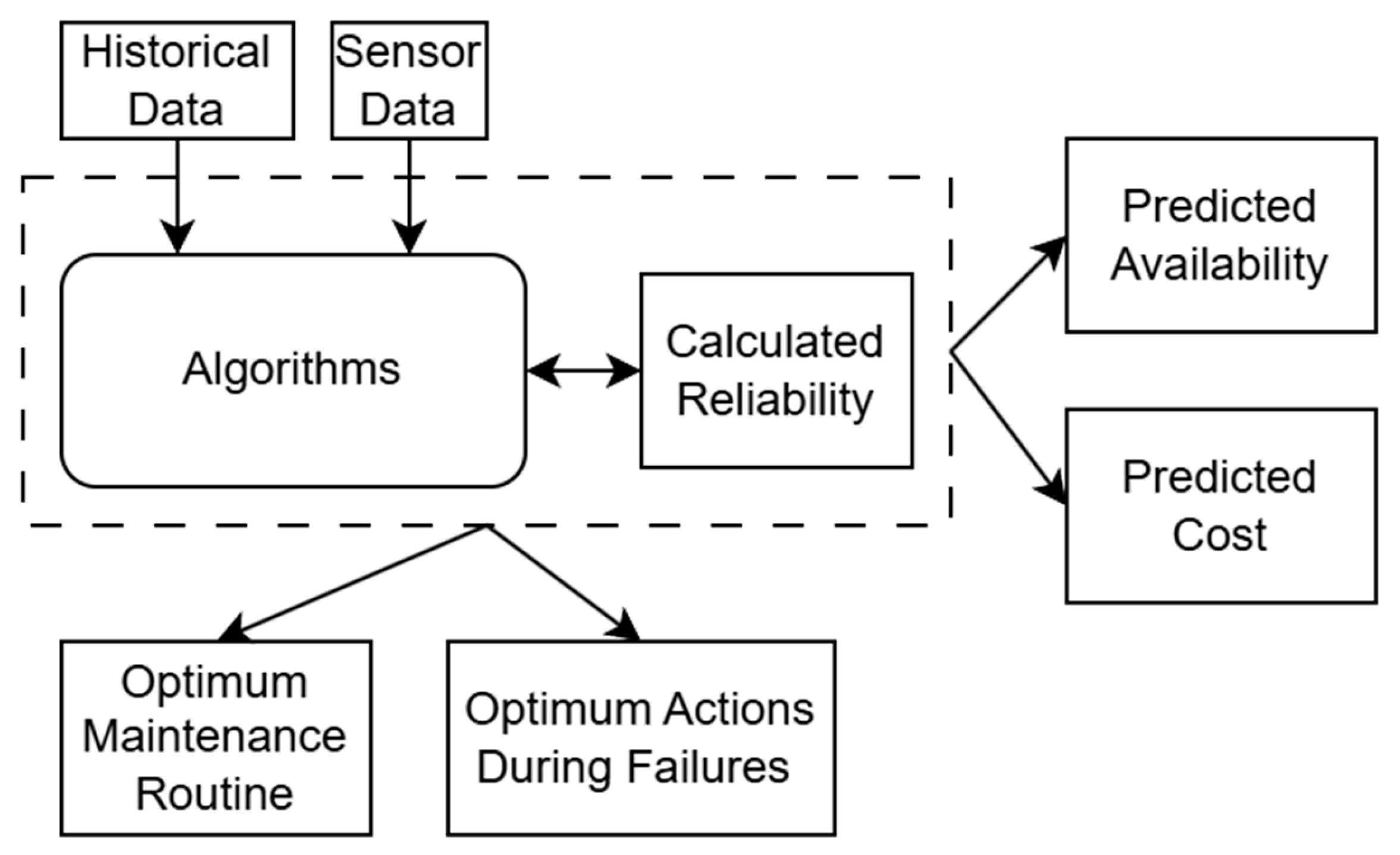


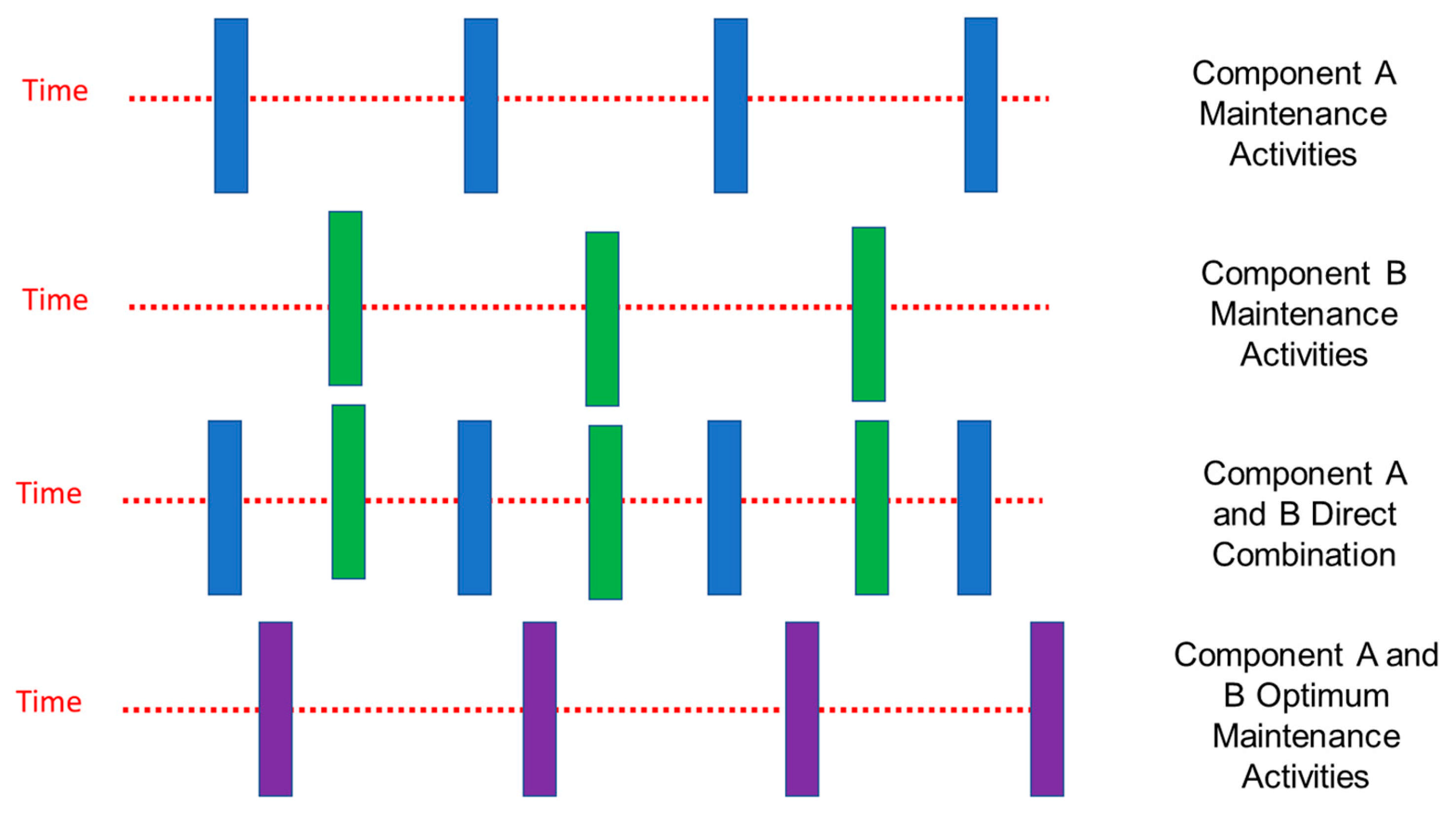
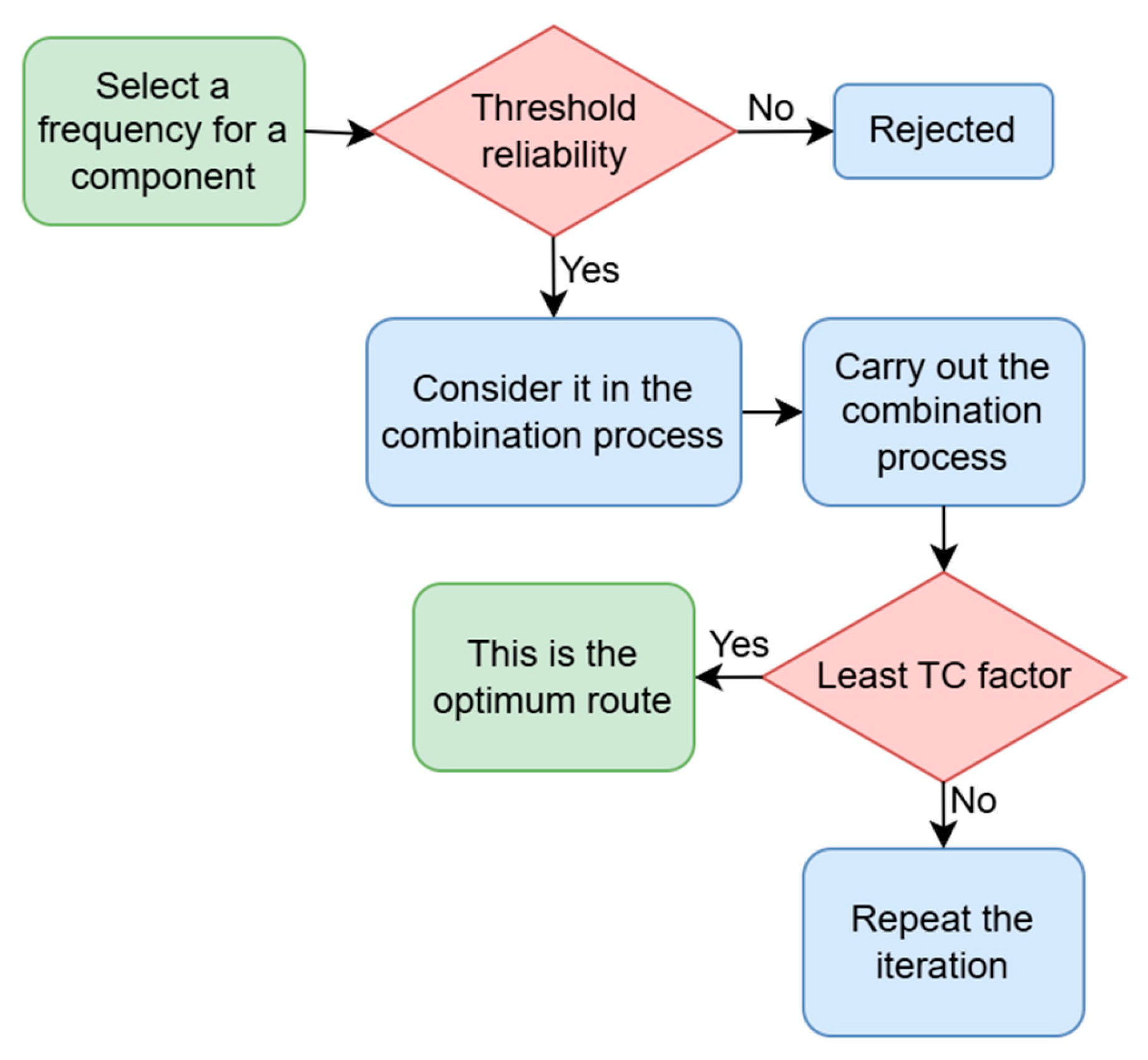
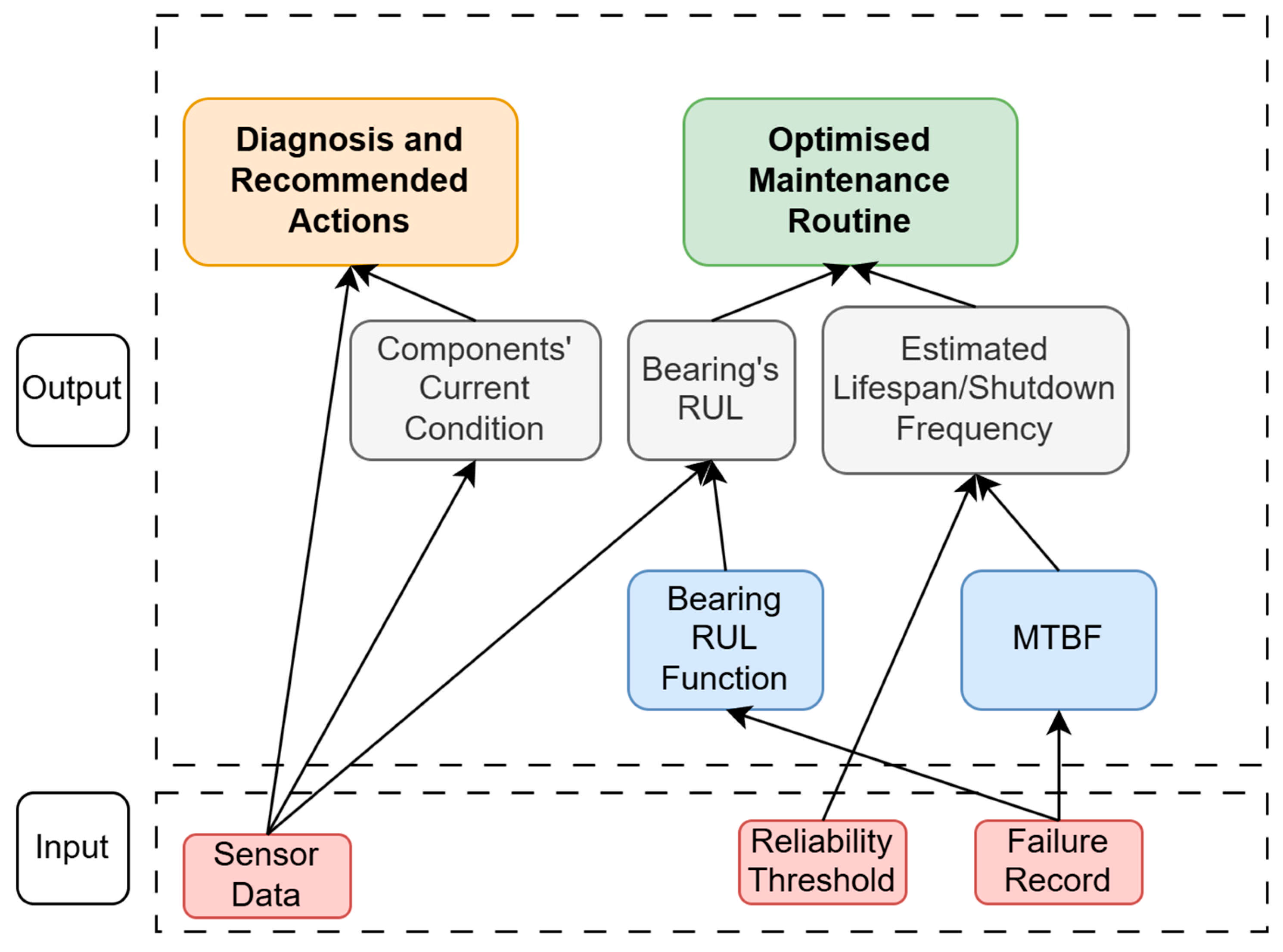
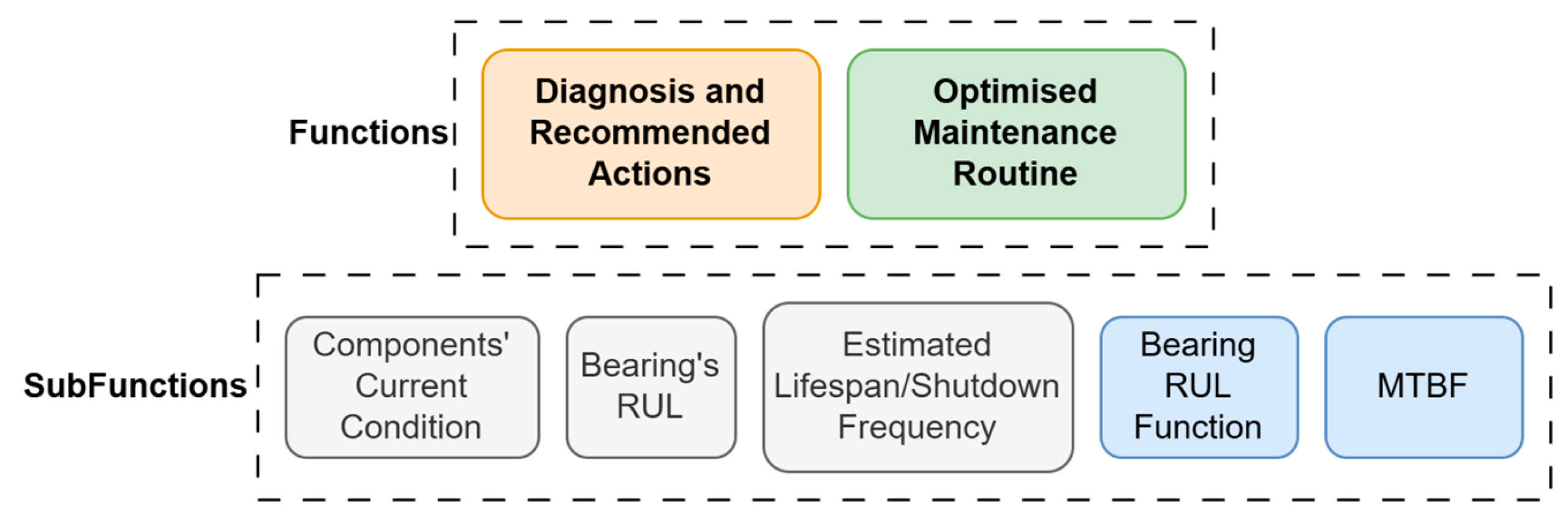

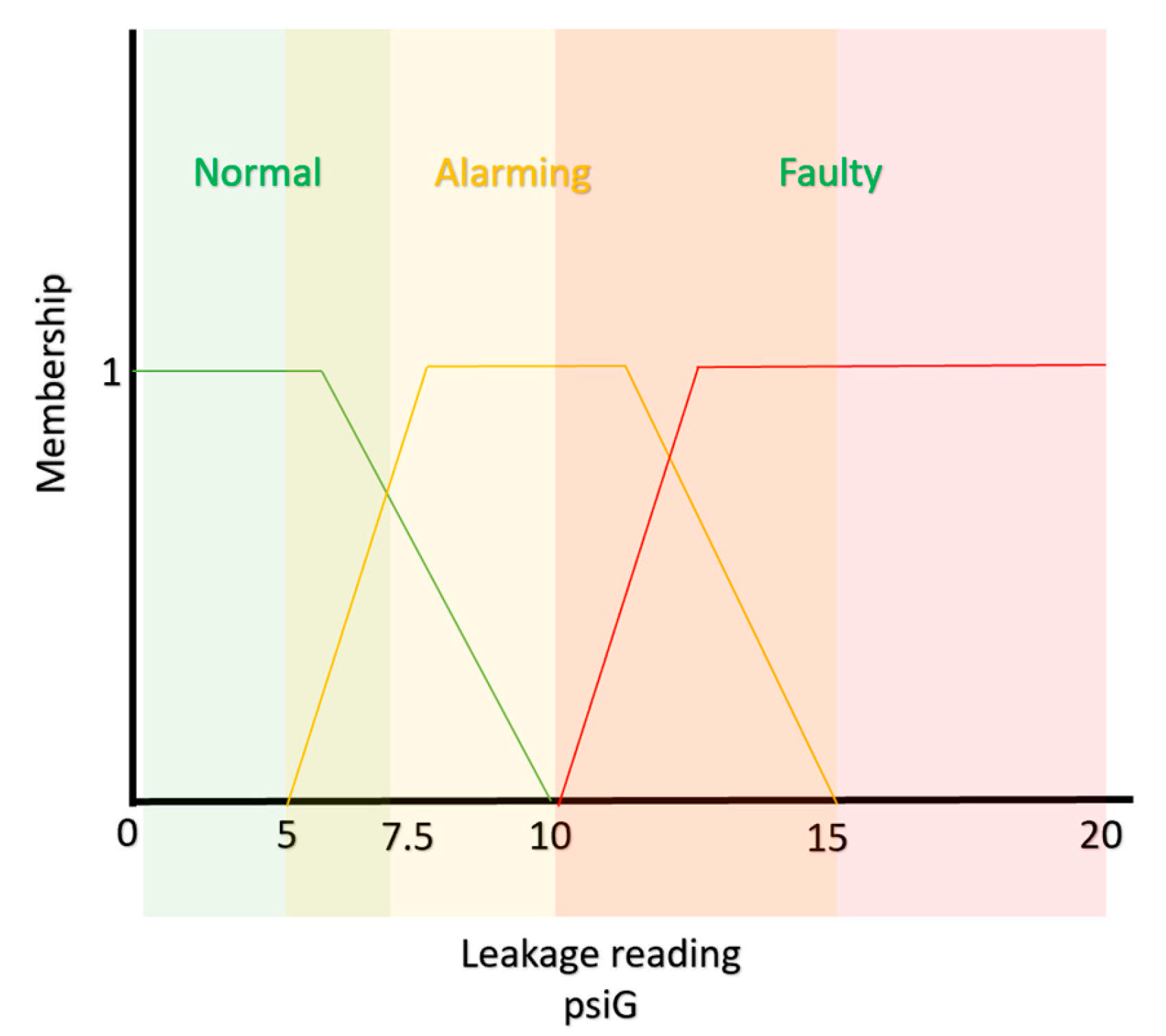

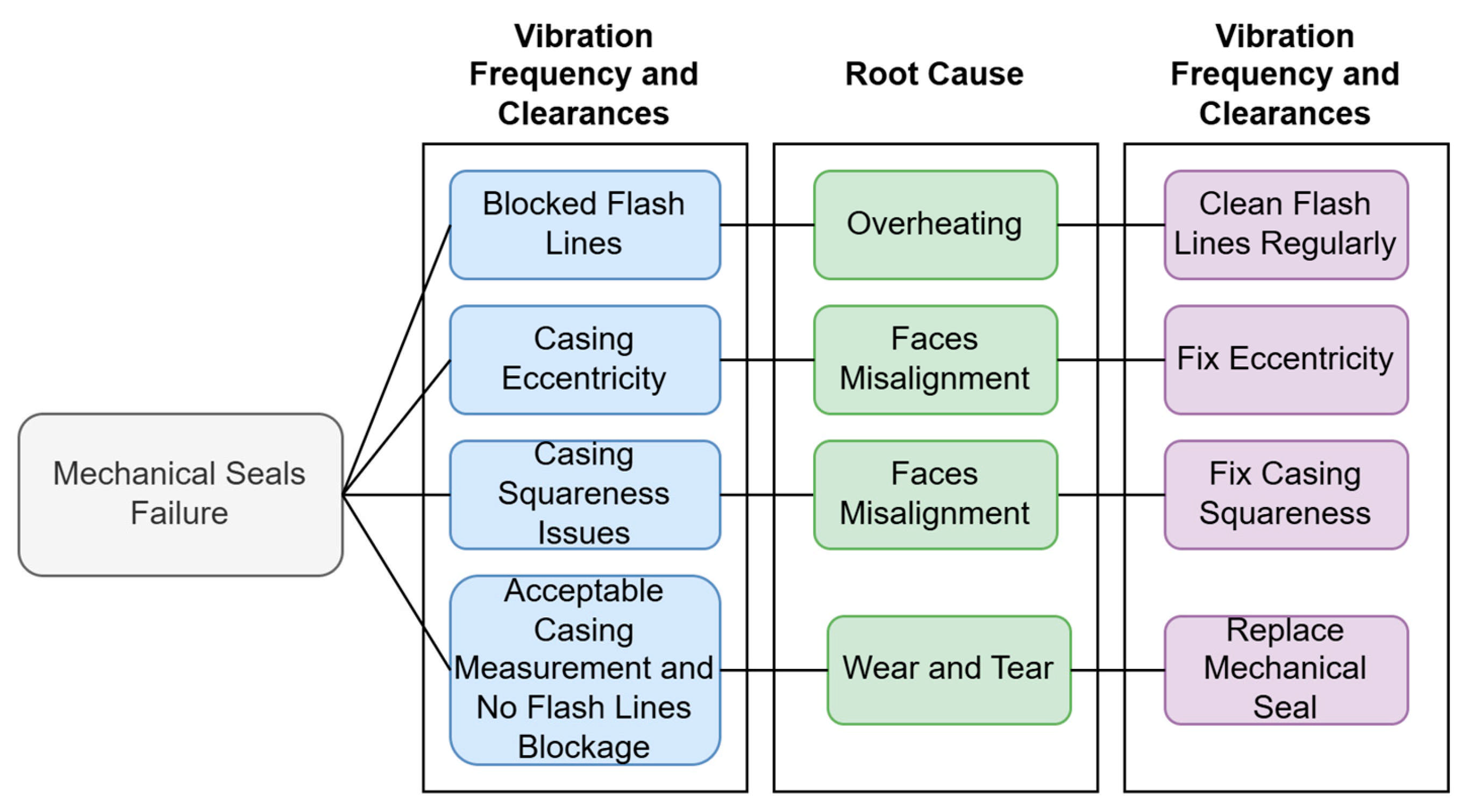
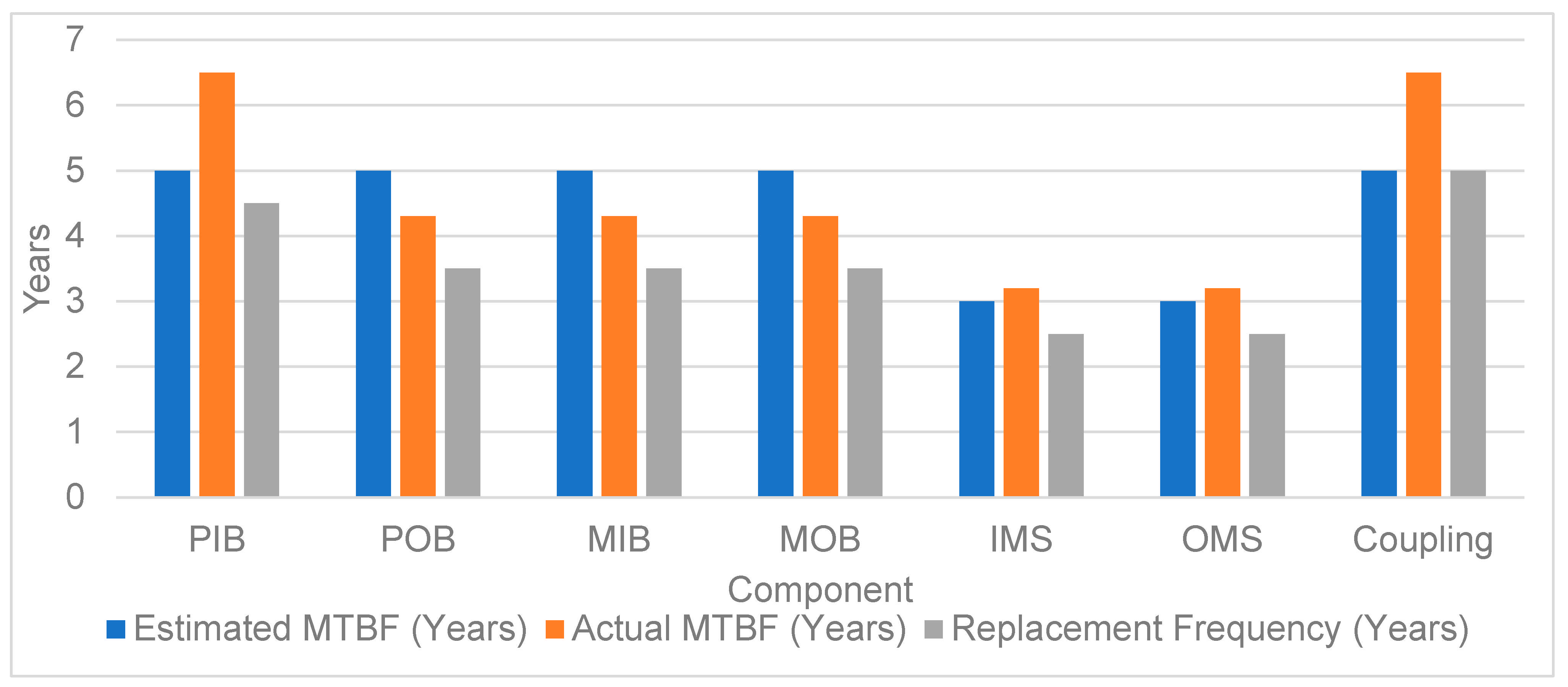

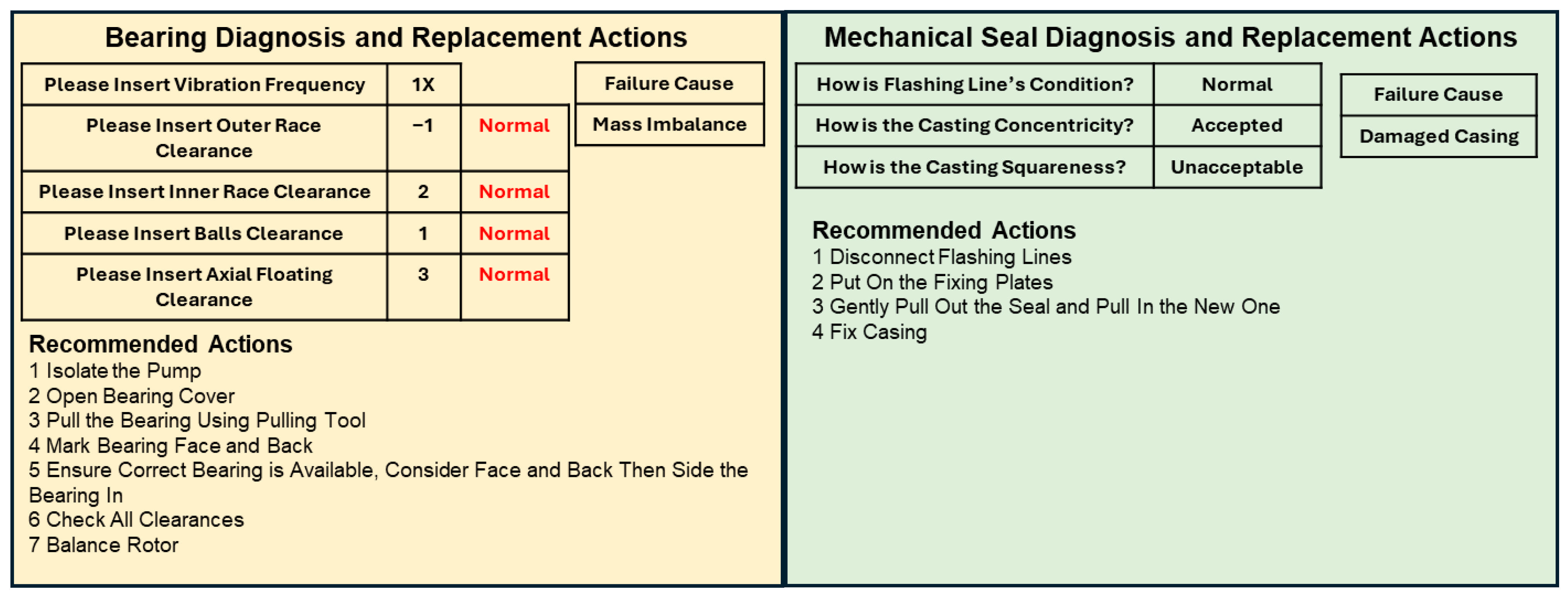
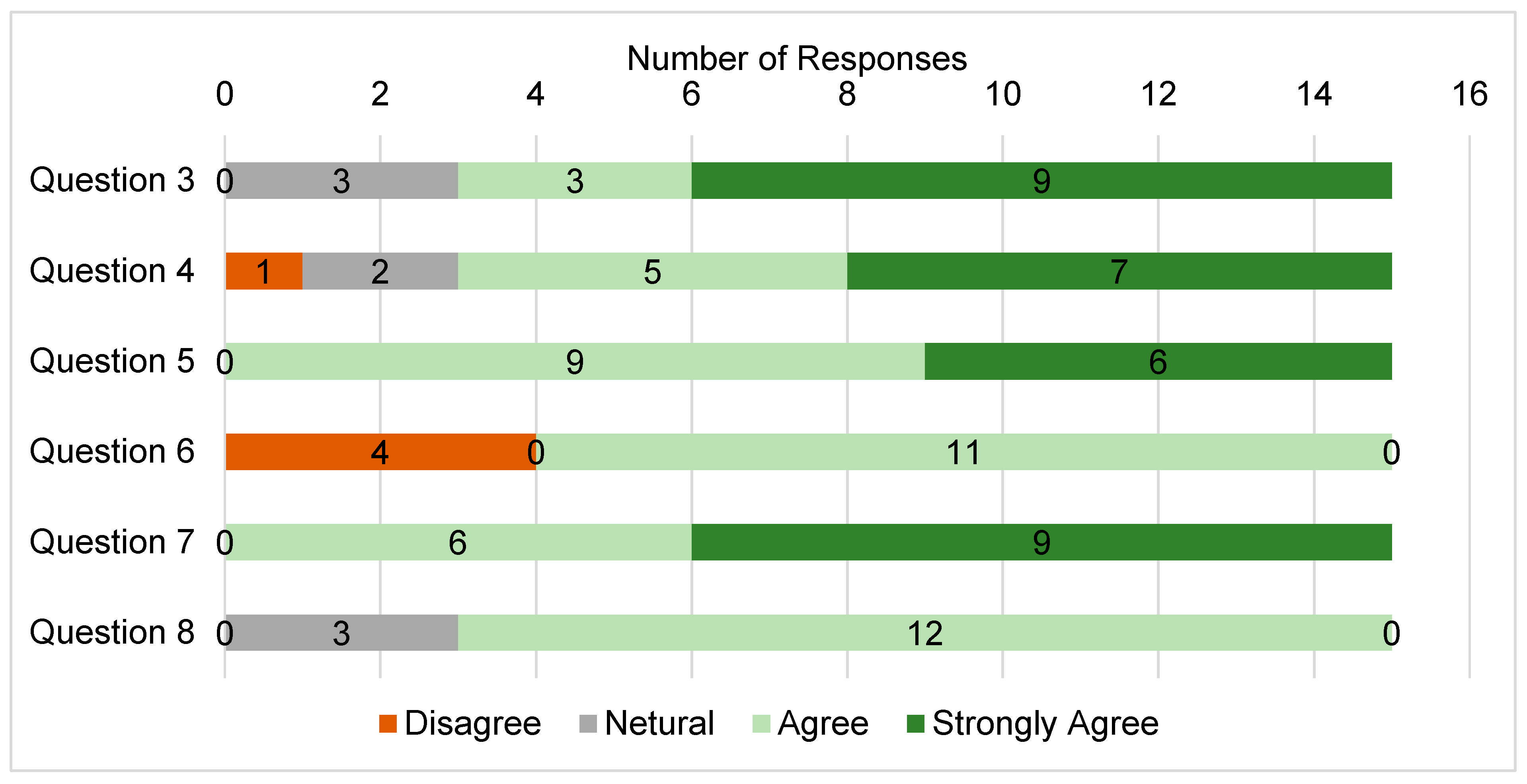
| Pump Components | Specification Data | |
|---|---|---|
| Pump Inboard Bearing (PIB) | Manufacturer | Byron Jackson® (Woodland, CA, USA) |
| Pump Outboard Bearing (POB) | Type–size | DSJH-10X14X20L |
| Motor Inboard Bearing (MIB) | Pump type | Horizontal |
| Motor Outboard Bearing (MOB) | Capacity | 4715 usgpm |
| Inboard Mechanical Seal (IMS) | Rated speed | 1770 rpm |
| Outboard Mechanical Seal (OMS) | Maximum allowable speed | 1800 rpm |
| Coupling | Total weight | 4873 lbs |
| Output | Description | Related Input |
|---|---|---|
| MTBFs | Components’ mean time between failures | Failures Record (history) |
| Bearing RUL Function | The function relates the vibration reading with the bearings’ RUL | Failures Record (history) |
| Estimated Lifespan/Shutdown Frequency | This is the estimated replacement time for each component | MTBFs, Reliability Threshold |
| Bearing RUL | The estimated bearings’ RUL based on the current vibration reading | Bearing RUL Function, Sensor Data |
| Components’ Current Condition | The current health condition of components based on the sensor data | Senor Data |
| Diagnosis and Recommended Actions | Failures diagnosis and recommended actions to reduce pumps’ downtime | Current Components’ Condition, Sensor Data |
| Optimised Maintenance Routine | The optimum maintenance routine in terms of pumps’ availability and cost | Estimated Lifespan/Shutdown Frequency, Bearings’ RUL |
| Input Data | Features | Limitations |
|---|---|---|
| Components’ Failure Record | Accurate | Very limited size |
| Used easily to calculate MTBFs | ||
| Single dimensional | ||
| Sensors’ Historical Data | Shows certain patterns | Very limited size |
| Single dimensional | ||
| Real-Time Sensor Data | Accurate | Limited databases |
| Detailed to support diagnosis | ||
| Single dimensional |
| Route 1 | Route 2 | |
|---|---|---|
| Pump IB Bearing | 1,507,364 | 1250 |
| Pump OB Bearing | 2,261,046 | 2500 |
| Motor IB Bearing | 2,261,046 | 2500 |
| Motor OB Bearing | 2,261,046 | 2500 |
| IB Mechanical Seal | 3,023,763 | 10,000 |
| OB Mechanical Seal | 3,023,763 | 10,000 |
| Coupling | 1,508,267 | 2000 |
| Total | 1,584,6293 | 2,530,750 |
| Route 1/Route 2 | 6.26 | |
| Number of Experts | Expertise Field | Employer |
|---|---|---|
| 5 | Maintenance engineers | Saudi Aramco |
| 4 | Maintenance engineers | SABIC |
| 3 | Maintenance Managers | Saudi Aramco |
| 3 | Maintenance Technicians | Saudi Aramco |
Disclaimer/Publisher’s Note: The statements, opinions and data contained in all publications are solely those of the individual author(s) and contributor(s) and not of MDPI and/or the editor(s). MDPI and/or the editor(s) disclaim responsibility for any injury to people or property resulting from any ideas, methods, instructions or products referred to in the content. |
© 2025 by the authors. Licensee MDPI, Basel, Switzerland. This article is an open access article distributed under the terms and conditions of the Creative Commons Attribution (CC BY) license (https://creativecommons.org/licenses/by/4.0/).
Share and Cite
Almuraia, A.; He, F.; Khan, M. AI-Driven Maintenance Optimisation for Natural Gas Liquid Pumps in the Oil and Gas Industry: A Digital Tool Approach. Processes 2025, 13, 1611. https://doi.org/10.3390/pr13051611
Almuraia A, He F, Khan M. AI-Driven Maintenance Optimisation for Natural Gas Liquid Pumps in the Oil and Gas Industry: A Digital Tool Approach. Processes. 2025; 13(5):1611. https://doi.org/10.3390/pr13051611
Chicago/Turabian StyleAlmuraia, Abdulmajeed, Feiyang He, and Muhammad Khan. 2025. "AI-Driven Maintenance Optimisation for Natural Gas Liquid Pumps in the Oil and Gas Industry: A Digital Tool Approach" Processes 13, no. 5: 1611. https://doi.org/10.3390/pr13051611
APA StyleAlmuraia, A., He, F., & Khan, M. (2025). AI-Driven Maintenance Optimisation for Natural Gas Liquid Pumps in the Oil and Gas Industry: A Digital Tool Approach. Processes, 13(5), 1611. https://doi.org/10.3390/pr13051611







